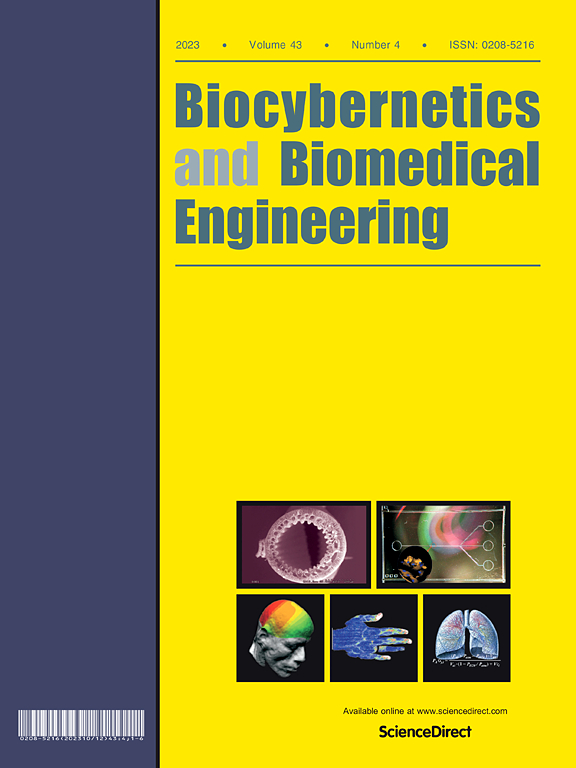一种新的本体感觉敏锐度测量装置:对年轻人和老年人的效度和信度分析
IF 6.6
2区 医学
Q1 ENGINEERING, BIOMEDICAL
引用次数: 0
摘要
年龄、神经退行性疾病、糖尿病和运动损伤都会损害本体感觉,即平衡控制和步态的关键感觉反馈系统。本研究的目的是评估最近建造的测量本体感觉功能的装置的有效性和可靠性。对47名参与者进行了评估,其中包括26名年轻健康成年人(20-40岁)和21名老年人(65岁)。测量踝关节运动感(SoM)灵敏度和位置感(SoP,主动/被动)敏锐度。采用类内相关系数(Intraclass Correlation Coefficient, ICC)和受试者工作特征曲线下面积(Area Under Receiver Operating Characteristic Curve, AUC-ROC)作为信度和效度指标。结果显示,SoM对背屈(年轻人ICC = 0.985,老年人ICC = 0.98)和跖屈(年轻人ICC = 0.972,老年人ICC = 0.982)的敏感性具有良好的可靠性。在被动SoP敏锐度上也观察到较高的信度(ICC = 0.825 ~ 0.989)。然而,活性SoP敏锐度法的可靠性较差至中等。AUC-ROC值证明了强的判别效度,SoM敏感性区分年轻和老年参与者,准确率超过91%。Bland-Altman分析显示,SoM灵敏度(18%至40%的设备精度)比被动SoP灵敏度(70%至90%的设备精度)更为一致,并且最小的系统偏差(- 0.03至- 0.01度)显示了日间测试-重测可靠性。根据这些结果,该装置可以有效地评估本体感觉功能,特别是SoM敏感性,并且可能在临床和研究环境中有用。本文章由计算机程序翻译,如有差异,请以英文原文为准。
A novel device for proprioceptive acuity measurement: Validity and reliability analysis in young and older adults
Age, neurodegenerative diseases, diabetes, and sports injuries can all impair proprioception, i.e. a crucial sensory feedback system for balance control and gait. The purpose of this study was to assess the validity and reliability of a recently constructed device for measuring proprioceptive function. Forty-seven participants, comprising 26 younger healthy adults (20–40 years) and 21 older adults (> 65 years), were evaluated. The ankle’s sense of motion (SoM) sensitivity and sense of position (SoP, active/passive) acuity were measured by the device. The Intraclass Correlation Coefficient (ICC) and the Area Under the Receiver Operating Characteristic Curve (AUC-ROC) were used as indicators of reliability and validity. The results showed excellent reliability for SoM sensitivity in dorsiflexion (ICC = 0.985 for younger, 0.98 for older) and plantarflexion (ICC = 0.972 for younger, 0.982 for older). High reliability was also observed in passive SoP acuity (ICC = 0.825 – 0.989). However, the reliability of the active SoP acuity method was poor to moderate. Strong discriminative validity was demonstrated by the AUC-ROC values, with SoM sensitivity distinguishing between younger and older participants with an accuracy of over 91 %. Bland-Altman analysis revealed tighter agreement for SoM sensitivity (18 to 40 % of the device precision) than passive SoP acuity (70 to 90 % of the device precision), as well as minimal systematic bias (−0.03 to −0.01 degrees) to show interday test–retest reliability. According to these results, the device is valid for evaluating proprioceptive function, particularly SoM sensitivity, and it may be useful in clinical and research settings.
求助全文
通过发布文献求助,成功后即可免费获取论文全文。
去求助
来源期刊

Biocybernetics and Biomedical Engineering
ENGINEERING, BIOMEDICAL-
CiteScore
16.50
自引率
6.20%
发文量
77
审稿时长
38 days
期刊介绍:
Biocybernetics and Biomedical Engineering is a quarterly journal, founded in 1981, devoted to publishing the results of original, innovative and creative research investigations in the field of Biocybernetics and biomedical engineering, which bridges mathematical, physical, chemical and engineering methods and technology to analyse physiological processes in living organisms as well as to develop methods, devices and systems used in biology and medicine, mainly in medical diagnosis, monitoring systems and therapy. The Journal''s mission is to advance scientific discovery into new or improved standards of care, and promotion a wide-ranging exchange between science and its application to humans.
 求助内容:
求助内容: 应助结果提醒方式:
应助结果提醒方式:


